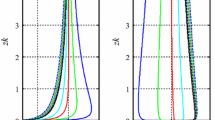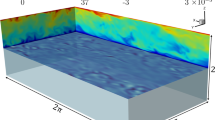Abstract
A wind-wave generation model over an ice-covered sea is proposed. The wind velocity over the ice upper surface is decomposed into the mean velocity profile of the boundary-layer flow and small perturbations, while the ice cover is modelled as a viscoelastic layer, with the water part modelled as an inviscid fluid. The present model is based on two-dimensional linear flow-instability theory, with no-slip boundary conditions at the air–ice interface, and both normal and shear stress boundary conditions matched on the air–ice interface. It is shown that the model converges to the field and experimental data for open-water cases. The ice elasticity is found to be the critical factor for generating wind waves, and the generation of flexural-gravity waves and elastic waves in ice is analyzed.










Similar content being viewed by others
References
Cheng SK, Rogers WE, Thomson J, Smith M, Doble MJ, Wadhams P, Kohout AL, Lund B, Persson OPG, Collins CO, Ackley SF, Montiel F, Shen HH (2017) Calibrating a viscoelastic sea ice model for wave propagation in the arctic fall marginal ice zone. J Geophys Res Oceans 122(11):8770–8793
De Carolis G, Desiderio D (2002) Dispersion and attenuation of gravity waves in ice: a two-layer viscous fluid model with experimental data validation. Phys Lett A 305:399–412
Fox C, Squire V (1990) Reflection and transmission characteristics at the edge of shore fast sea ice. J Geophys Res Oceans 95:11629–11639
Keller J (1998) Gravity waves on ice-covered water. J Geophys Res Oceans 103:7663–7669
Lamb H (1993) Hydrodynamics. Cambridge University Press, Cambridge
Larson T, Wright J (1975) Wind-induced gravity-capillary waves: laboratory measurements of temporal growth rates using microwave backscatter. J Fluid Mech 70(03):417–436
Liu A, Mollo-Christensen E (1988) Wave propagation in a solid icepack. J Phys Oceanogr 18:1702–1712
Miles J (1957) On the generation of surface waves by shear flows. J Fluid Mech 3:185–204
Peters A (1950) The effect of a floating mat on water waves. Commun Pure Appl Math 3:319–354
Plant W (1982) A relation between wind stress and wave slope. J Geophys Res 83:1961–1967
Shemdin O, Hsu E (1967) Direct measurement of aerodynamic pressure above a simple progressive gravity wave. J Fluid Mech 30(2):403–416
Shen H (2019) Modelling ocean waves in ice-covered seas. Appl Ocean Res 83:30–36
Snyder R, Dobson F, Elliott J, Long R (1981) Array measurements of atmospheric pressure fluctuations above surface gravity waves. J Fluid Mech 102:1–59
Thomson J, Rogers E (2014) Swell and sea in the emerging arctic ocean. Geophys Res Lett 41:3136–3140
Thomson J, Ackley S, Girard-Ardhuin F, Ardhuin F, Babanin A, Boutin G, Brozena J, Cheng SK, Collins C, Doble M, Fairall C, Guest P, Gebhardt C, Gemmrich J, Graber HC, Holt B, Lehner S, Lund B, Meylan MH, Maksym T, Montiel F, Perrie W, Persson O, Rainville L, Rogers WE, Shen H, Squire V, Stammerjohn S, Stopa J, Smith MM, Sutherland P, Wadhams P (2018) Overview of the arctic sea state and boundary layer physics program. J Geophys Res Oceans 123:8674–8687
Van Duin C, Janssen P (1992) An analytic model of the generation of surface gravity waves by turbulent air flow. J Fluid Mech 236:197–215
Wang R, Shen H (2010) Gravity waves propagating into an ice-covered ocean: a viscoelastic model. J Geophys Res Oceans 115:C06024
Weitz M, Keller J (1950) Reflection of water waves from floating ice in water of finite depth. Commun Pure Appl Math 3:305–318
Wu H, Hsu E, Street R (1977) The energy transfer due to air-input, non-linear wave-wave interaction and white cap dissipation associated with wind-generated waves. Stanford Univ Tech Rep 207:1–158
Wu H, Hsu E, Street R (1979) Experimental study of nonlinear wave-wave interaction and white-cap dissipation of wind-generated waves. Dyn Atmos Oceans 3:55–78
Yeo K (1988) The stability of boundary-layer ow over single and multi-layer viscoelastic walls. J Fluid Mech 196:359–408
Zhao X, Shen H (2015) Wave propagation in frazil/pancake, pancake, and fragmented ice covers. Cold Reg Sci Technol 113:71–80
Zhao X, Shen H (2018) Three-layer viscoelastic model with eddy viscosity effect for flexural-gravity wave propagation through ice cover. Ocean Model 131:15–23
Zhao X, Cheng S, Shen H (2017) Nature of wave modes in a coupled viscoelastic layer over water. ASCE J Eng Mech 143(10):04017114
Acknowledgements
The present study is funded by the National Key Research and Development Program of China #2018YFA0605902 and the National Natural Science Foundation of China, #41776194.
Author information
Authors and Affiliations
Corresponding author
Additional information
Publisher's Note
Springer Nature remains neutral with regard to jurisdictional claims in published maps and institutional affiliations.
Appendix: Reduced Boundary-Condition Equations
Appendix: Reduced Boundary-Condition Equations
The reduced boundary-condition equations in terms of the potential functions and stream-functions for the wind-wave generation model are
With (31) and (32), we eliminate the streamfunction \( \psi_{0} \) in (33) and (34). Finally, six boundary conditions are reduced to four equations for the coefficients A, B, C, and D, which enables solution the determinant of this 4 × 4 system to obtain the dispersion relation.
Rights and permissions
About this article
Cite this article
Zhao, X., Zhang, C. A Theoretical Model of Wind-Wave Growth Over an Ice-Covered Sea. Boundary-Layer Meteorol 178, 1–19 (2021). https://doi.org/10.1007/s10546-020-00552-7
Received:
Accepted:
Published:
Issue Date:
DOI: https://doi.org/10.1007/s10546-020-00552-7




